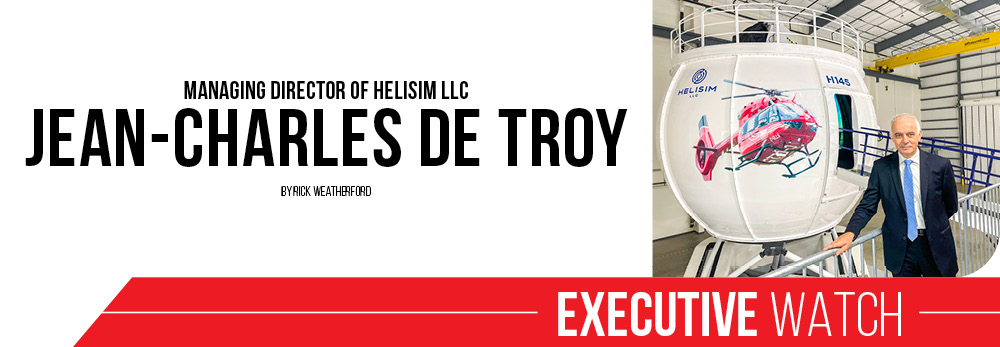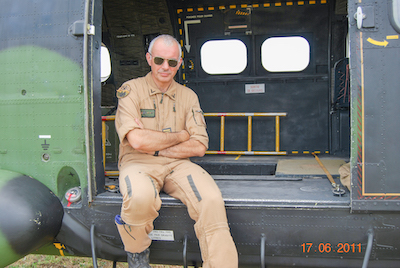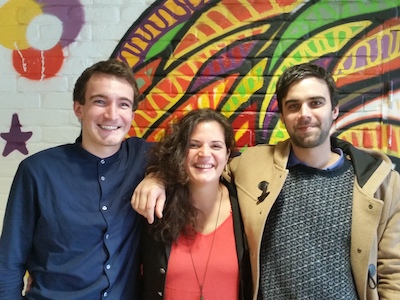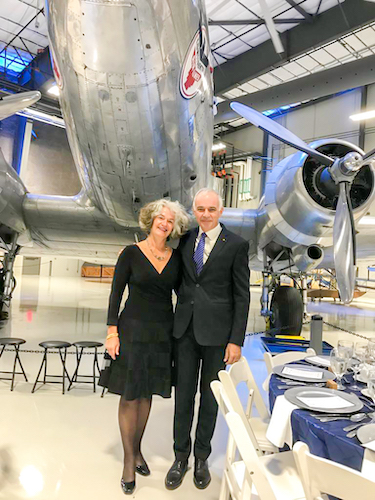|
Jul
12
2021
|
|
Posted 4 years 190 days ago ago by Admin
|
|

“I have the best job in the world. If I have to start over again, I’d do this job exactly the same.” That’s a rarely heard bold statement in any industry, but Jean-Charles de Troy, managing director of Helisim LLC, proudly proclaims it from deep in the heart of Texas where he helped establish Helisim in North America. Helisim, with centers in both France and Texas was founded 21 years ago from a consortium of Airbus, Thales AVS, and Défense Conseil International. It is a pilot’s pilot training company—literally. For de Troy comes from a father who was a Bird Dog pilot for France in the Algerian War and who continued to fly as a private pilot for pleasure. He passed his love of aviation on to his son, who says, “Flying is in my DNA.” As a young child, de Troy always had a toy airplane in his hand, which he would put down to hold one of his very first books The Little Aviator. The story stuck. Even when de Troy was old enough to work alongside his two sisters in their parents’ restaurant, named Le Chanzy, in the northern French town of Arras, he dreamed of being a pilot.
Military Career
Upon graduating high school, de Troy applied for a French army aviation position and was accepted for training. “They proposed that I fly helicopters and I agreed because I just wanted to be a pilot. It was fun and I’ve never stopped flying helicopters anytime in my career,” de Troy says. He got his rotorcraft wings in 1984, and flexed them by flying the Alouette II and Alouette III for six years close to the German border.
He was selected to be an instructor pilot, a position he took because it would keep him in the air. “I wanted to fly, fly, fly all the time,” he says, and his instructing aircraft was a great one—the Gazelle. “It’s a super fun helicopter to fly when it’s not loaded down for deployment,” he says. “When it’s light, it’s very agile and very fast, like a sports car.” Sports cars are mostly for the young and carefree. “As you get a bit older, you start to consider other things,” de Troy says. With his wife, Veronique, and children to consider, de Troy joined the army aviation commissioned officer course and turned to flying heavier helicopters, like the Puma, on many deployments in diverse places: the former Yugoslavia, Albania, Chad, Cameroon, Congo, and… you get the idea. In 2001, the army gave him an army logistics supply squadron to lead, so de Troy led a squadron for two years that flew more than 10,000 hours under his command. The next two years, he served as an army aviation safety officer. Immediately after that, it was off to Morocco, as an expert advisor, where de Troy helped set up two training programs for Moroccan helicopter pilots. “I was the only non-Moroccan pilot at the Moroccan base and I flew a lot. It was a great experience for sure,” he says.

After Morocco, de Troy headed back to France’s army aviation school where he eventually became commander for all helicopter aviation training. He retired from his military career in December, 2013, after 31 years of service. After joining the army as a non-commissioned officer, de Troy left as a lieutenant colonel. “It was a great career,” he recalls.
Civilian Career
De Troy retired from the army, but hardly from flying and training. He wasted no time—not even a day—transitioning from the military to a civilian career. How so swiftly? About half a year before his military retirement, friends at Airbus approached the aviation training commander to gage his interest in becoming the training director for their simulator center—Helisim. After he learned he could still engage in flying, de Troy was sold. “The day after my military retirement, I started as their training director. It was an easy move,” he says with record-setting understatement.
That first quick career move became a global move in 2018 from Marignane, France, to Grand Prairie, Texas, when Helisim moved de Troy to manage the launch of their new training center at Airbus Helicopters’ North American headquarters. De Troy was ready to go, but his wife had one requirement to make the move. She said, “OK, but when we move, I want one thing: I want to drive a big red pickup truck,’” de Troy chuckled. Veronique now drives her big, red Dodge Ram like a Texas cowgirl. [This anecdote was originally reported by Dan Reed in HAI’s Rotor magazine.]
With his wife situated with suitable Texas wheels, de Troy jumped into building a visionary training center, literally from the ground up. “We started building from a patch of dirt and an old volleyball playground. Building from scratch was super exciting,” he says.
That excitement is well founded. Helisim’s original center in France, serves approximately 3,000 trainees a year with seven simulators, most rated at Level D. Texas is quickly catching up to match the pace in France. Texas started with an advanced H145 simulator and just began operating a new Thales Reality H full-motion flight simulator. They expect to add a simulator for the H160 within the next couple of years. The Grand Prairie facility is large enough to also house an H175 simulator. Although the COVID pandemic curtailed the number of trainees coming through, Helisim in Texas is expecting to build up to 3,000 trainees annually. They currently serve up to 1,500 pilots.
De Troy deeply cares that those trainees leave flying safer than when they arrived. “I personally want our trainees to be safer pilots when they leave. If they need some extra minutes in the sim to understand something that will make them safer, my first inclination is not to charge them extra. Let’s learn what we need to learn to be safer in the air and prevent an accident,” he says. “Most accidents are pilot induced and better training can reduce those types of accidents.” When asked what is the key to success for pilots, de Troy answers, “For pilot success, you must stay humble (he is not above getting—and making—coffee for subordinates). I really think a pilot who is not humble is in danger.”
Family & Leisure
De Troy humbles himself by comparing himself to his wife. When asked what he considers his greatest professional accomplishment, he shifts his answer from himself to Veronique. The travel and time that both his globe-hopping military and Helisim careers have demanded of him, his wife, and their children are the type of demands that dissolve many families. One time he was deployed for five months in Djibouti and was home only one week when he was suddenly deployed for a NATO exercise in Norway. “I barely had time to pack up my African stuff before I headed to Norway. My wife was again alone to raise our three kids,” he says with a tinge of melancholy. “She deserves so much credit for our success and for our marriage.” He unhesitatingly says that his greatest professional accomplishment is that his family stayed happily together throughout his career. “That is mostly due to my wife,” he says. “My children’s success also is mostly due to my wife.” (Their daughter is a veterinarian in the Caribbean, while one son is an IT security scientist and the other son works for an organic food company in Paris.)

As aviation is integral to who de Troy is (remember, he said it’s in his DNA.) it’s no surprise that he met his wife at an airfield over 30 years ago. She is a rated glider pilot and the couple often fly a Cessna for pleasure on weekends. Their shared interest in flying along with hiking and nightly dinners together, strengthens their relationship. De Troy doesn’t like to watch TV, so he has more time each evening to talk with Veronique. When their nightly dinner conversations conclude, he then turns to his other passion—reading. “I read anything because I like to read a lot. It could be an accident report or a book,” he says.

A recently read book gave him insight into piloting accidents: Thinking Fast and Slow by Daniel Kahneman. “It’s interesting because it describes how our brains work and that can apply to aviation accidents.” De Troy uses flying the H145 as an example: “You push a button and engage autopilot and can start talking sports with your copilot. But that flight can quickly turn into a nightmare without the pilots really understanding how the accident developed.” Learning how our brains think might help us understand that accident process better. “Flying can be very simple, yet very hard to understand. It is difficult to trust what you don’t understand,” he says. “Most pilots are impressed by all the fancy avionics we have, but many don’t really understand their autopilot. If they get in an unexpected situation because they don’t understand and trust their autopilot, they will disconnect it and that is usually a super bad idea.”
De Troy and Helisim want to replace those bad reflexive decisions with safer instincts. He uses the hazardous conditions of North Shore oil rig flying off the coast of Norway and Sweden as an example of what good training can accomplish. “It’s not nice to fly up there, yet their accident rate is very low. They have frequent training that allows them to react to changing situations without thinking every step through. It becomes like a reflex to do the right thing,” he says. “We can do that here; it’s possible to significantly reduce accidents through training. We have the opportunity now to offer frequent, efficient, very realistic, and affordable training.”
Yet, even with that type of training, there will always be an element of luck involved with being a helicopter pilot. De Troy’s final story explains, “A French astronaut was training in Houston to go up to the International Space Station. I met him at the French consulate and we began talking about pilot stuff. I told him I did helicopter training and he responded, ‘Oh, I’d love to fly a helicopter one day!’ So, even cosmonauts dream of flying helicopters. That they dream of flying helicopters shows how lucky we are!”